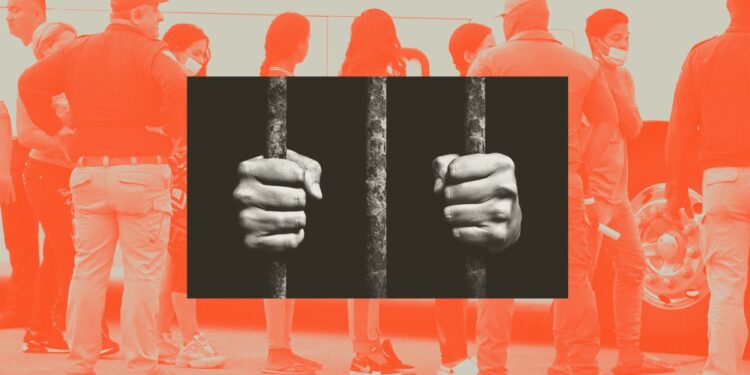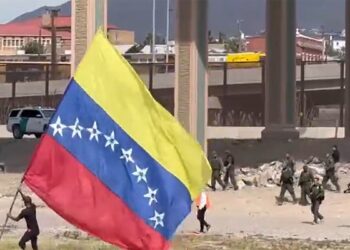Three days after Donald Trump’s second inauguration, White House press secretary Karoline Leavitt declared an early accomplishment: the arrest, and deportation, of hundreds of immigrants she alleged were convicted of crimes. “We’re getting the bad, hard criminals out,” Trump told reporters the next day.
This has been the refrain from all corners of the administration. On multiple TV appearances, Trump’s faithful border czar Tom Homan has described US Immigration and Customs Enforcement (ICE) operations taking place across the country as precisely orchestrated roundups of criminals. “I wouldn’t call them raids,” Homan told CNN’s Dana Bash. “They’re targeted enforcement operations. They know exactly who they’re looking for.”
“Nobody’s showing me that there are more convicted criminals.”
So far, the numbers tell a different story.
As NBC News first reported, almost half of the roughly 1,200 arrests ICE conducted on Sunday didn’t fall under “criminal arrests.” Instead, agents targeted hundreds of undocumented immigrants who had committed nonviolent crimes or had crossed the border in violation of immigration laws, which is a civil, not criminal, offense. And it didn’t take long for news to surface of US citizens getting caught in the dragnet and immigrants facing deportation as a result of routine traffic stops.
“They are arresting more people today than last year, I believe them when they say that,” says Jason Houser, who served as chief of staff for US Immigration and Customs Enforcement (ICE) during the Biden presidency. “But nobody’s showing me that there are more convicted criminals. Nobody’s showing me that there are more removable people coming into custody. Nowhere in the first 12 days have you seen one tangible step to fix the system.”
In an interview with Mother Jones on Thursday, Houser slammed the Trump administration’s immigration crackdown and explained why it would do little to improve public safety.
This conversation has been edited for length and clarity.
From what you’ve observed so far, has there been anything unprecedented about the scale or scope of these ICE operations compared to the previous administration? Or do they strike you as business as usual?
The media bluster. The steps I’ve seen over the first 12 days, ICE operations are just doing some collateral arrests to jack up the arrest number because that seems to be the narrative that the White House wants to give. They’re [saying] mass deportation has begun and here’s these arrests—and the media has lost its mind [with] these numbers that Trump keeps giving them. But flashy media hits and Kristi Noem in the Bronx doesn’t do anything.
What I see operationally is ICE staff being pulled from doing arrests in their home areas and condensed in these large cities for larger-scale operations for public media campaigns. That doesn’t help ICE do its work day to day. Strategically, I’ve seen probably the most anti-law enforcement steps, anti-public safety threats of any president.
How so?
We saw them do away with the [CHNV parole] pathway program at the border. That’s a law enforcement program that pre-vets people through law enforcement, national security data when they enter the asylum process. That’s more public safety. Now those people are going to go back to the border and potentially come illegally putting more pressure on border patrol.
And they’ve redeployed ATF, FBI, DOJ to not do national security and public safety, but to go out and arrest non-criminal migrants. That’s less public safety.
They also froze all the grants that support state and local law enforcement to counter drugs—homeland security grants, the things that fund rural law enforcement. How the hell is any of this helping to make us more safe?
Both the Obama administration, in its later days, and the Biden administration had enforcement priority policies in place instructing ICE to focus on public safety threats and immigrants with serious criminal convictions. What do we know about the Biden presidency’s record on detention and deportation of immigrants with criminal records?
During Biden, criminally convicted individuals coming to ICE for removal were gone. So the more volume of convicted serious, violent offenses that I have in custody the more likely I am to remove them. But ICE only has 11 planes that hold 135 seats, and each country allows for X number of flights per month. Some of them have restrictions. Based on that calculus, you bring people into custody that are removable: they have final orders and they are from a country that takes removals. And let’s make sure the biggest public safety threats are on those seats. I don’t know what the administration is doing now, because they’re not talking about that piece. What they’re talking about is the arrest piece. They’re ranking up the volume of potential arrests or bookings.
The Washington Post reported that ICE officials have been instructed to establish daily arrest quotas—between 1,200 and 1,500 in total, or 75 per field office. What effect do you expect that to have on the agency’s work and staff morale?
The men and women that I was proud to work with are used to being the political football. That’s the space this has become. No one’s looking for the real answers. They’re just looking for a quick political solution. It’s going to make ICE take more people into custody and take in fewer public safety threats. And potentially doing it just for show because a lot of them don’t have final orders [of removal] or are from countries we don’t have removal flights to. You’re just going to be taking up a lot of their time with stuff that is not going to keep us more safe.
You are making ICE’s job harder and they have the hardest job in law enforcement. That’s the part where I will defend them. ICE’s staff wants to go after violent criminals. There are people that are taking advantage of our system that they need to go get and that’s who they should be focused on.
Border czar Tom Homan often talks about how sanctuary cities obstruct ICE’s work and force agents to conduct operations in apartment buildings or other areas instead of jails, therefore causing more “collateral arrests.” What do you make of that assertion?
People keep calling Tom Homan the “border czar.” What the hell does he have to do with the border? He is a deportation coordinator.
Houser said the “operationalization of [Guantanamo Bay] is farcical” and just “drool bait for people who want to be punitive to migrants.”
There’s a middle path here that is getting lost. ICE can still go arrest people in sanctuary cities and do at-large arrests. They’re just not getting the information sharing from the law enforcement agency in that sanctuary area. And that does make ICE’s work harder. It takes up their resources when they could be going after other things. I think it’s a political back-and-forth right now.
On Wednesday, President Trump signed the Laken Riley Act into law. It requires mandatory detention for undocumented immigrants merely accused of theft, shoplifting, and other related crimes. What do you anticipate the impact to be on ICE’s work?
Remember, ICE only has so many beds. In Rhode Island, for example, they have 980 ICE beds. How do you want to use them? Do you want to have Providence call and say, “Hey, I have a convicted rapist with a final order. Do you want to tell me to get him and put him in that bed?” Or do you want ICE going out and there’s a guy that’s been checking in for 10 years, had a petty theft offense a decade ago, and now ICE has to mandatorily put him in that bed? So convicted rapist not in bed; a theft offender from 10 years ago is in a bed. And if I have to bring in people that I can’t remove [from countries that don’t take deportees back, for example], somebody’s going to have to come out of ICE custody. It’s upside down.
All it’s going to do now is exacerbate DHS resources where they’re going to have to cut things like transportation security, potentially reprogram money from the border, turn off cyber security activity.
President Trump also said that he would be sending 30,000 of the “worst criminal illegal aliens” to Guantanamo Bay. What did you make of that?
The operationalization of that is farcical. We have a Navy base that was built in the 60s and that’s dilapidated and we’re now going to ferry 30,000 migrants there to live in soft-sided tents? We’re going to remove them to where? Who’s going to house them? Who’s going to feed them? Who’s going to give them sanitation? And when a hurricane hits, who’s going to secure them? Where’s the staff going to live? What status do they have? This is drool bait for people who want to be punitive to migrants. You’re politicizing ICE’s work.
“They see everything as: Are we winning the media today?”
We didn’t demystify in the Biden years the work that ICE does that keeps people safe. We just made it kind of this thing we did and we had to keep it quiet. I think we have to show that if we’re able to go after violent offenders who are taking advantage of our immigration system, that’s going to keep an immigration system for those that really need it. With the displacement that we see across the Western Hemisphere, and the volume of people that are dealing with life-and death-situations in these countries, and the fact that we have a need for immigration into our country: we have to message this better.
What do you expect to see in the coming weeks and months as the Trump administration continues to push for more arrests and deportations?
If the view is in the near term that all they want to do is give the show of force, the punitiveness of the system, the dismantling of the immigration system, and how arrest and enforcement are going to deter people, you’re going to see more of that in different ways. Sooner or later, they’re going to go do work site raids at some chicken plants in Arkansas or meat processing plants in Kansas or Tennessee. Then they’re going to start doing a family separation, arresting the head of the household, and saying you can voluntarily remove yourself or we’re just going to remove the breadwinner of the family and we’re going to separate you. You’re going to see permutations of these ideas because they believe that that will stop encounters at the border.
I think you’re going to see an expansive use of state and local law enforcement. If they do invoke the Alien and Sedition Act, they’ll move military equipment into large cities and just have it it there as a show of force. Indicators of change are family arrests, family detention, more collateral arrests, and worksite raids.
They see everything as: Are we winning the media today? Right now their program is let’s go to Aurora [in Colorado], let’s do the road show of enforcement. When we have no more blue cities to do that in, then we’ll pull up the worksite raids. This is about a messaging campaign. They’re going to continuously show the drumbeat that they’re doing what they said they are. Some of this is not pro-law enforcement, it is not pro-public safety, it is not back the blue.







